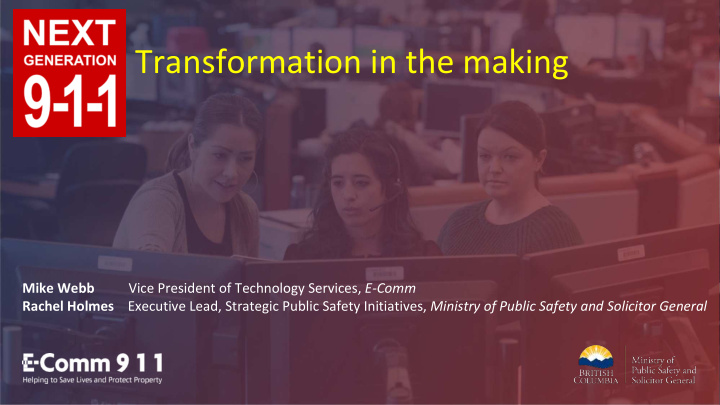



Transformation in the making Mike Webb Vice President of Technology Services, E-Comm Rachel Holmes Executive Lead, Strategic Public Safety Initiatives, Ministry of Public Safety and Solicitor General
The What The biggest change to 9-1-1 since first launched in Vancouver in 1976: § Major technology overhaul that will enable new ways of contact § Complex with far-reaching implications § Many unknowns 2
The Why Vision for NG 9-1-1 9-1-1 can communicate with any device, anywhere, anytime Drivers for Change Community Rapidly Evolving Availability of Shifting Global Expectations Technology Quality Information Practices Strategic Objectives Strategic Objective 2: Strategic Objective 1: Strategic Objective 3: Interoperable Systems & Enabling Technology Universal Access Agile Operating Model 3
The Where 4
The When CRTC: Telephone companies must § Provide NG 9-1-1 Voice Capable Networks by June 30 th 2020 § Provide Real-time Text (RTT) Capability by December 31 st 2020 § Decommission legacy 9-1-1 networks by December 31 st 2023 5
Universal Access Communicate with 9-1-1 call-takers using modern means… 6
…That are secure, reliable and instant… Real Time Text (RTT) is different from SMS text messaging 7
Interoperable systems Improved situational awareness, information sharing… The Emergency Communications Centre Real Time Situational Awareness Responders Sensors and Internet of Things Smart Devices 8
Enabling technology 9-1-1 can precisely locate a caller, no matter what… 103 Beaver Street 9
Agile Operating Model Increased flexibility and resilience… The Coast helps the Interior (or B.C. helps Alberta) Interior helps the Coast ( or Alberta helps B.C.) 10
Complexities and Impacts § Funding and resources to support transition Ø Technology purchase and implementation Ø Additional staffing and operating costs § Security, evidentiary and privacy concerns § New operating procedures and policies § Emotional toll on staff § Public awareness and use 11
Public Safety Answer Point Preparedness § Plan for new capital and operating expenditures § Operational training, Q/A and policies for handling real-time text § Plan for significant change management 12
E-Comm’s NG9-1-1 Proof of Concept § Q3 2019 – Q1 2020 § Maximize use of existing systems and applications: Ø Upgrade of call-handling platform Ø Enable NG-911 and non-emergency test calls (voice and RTT) § Inform plan for full provincial platform and service rollout for police, fire and ambulance agencies 13
911 Services in British Columbia Rachel Holmes Executive Lead Strategic Public Safety Initiatives Office of the Deputy Solicitor General
Public Safety Secondary PSAP Emergency Response BC EMERGENCY Answering Point (SSAP) COMMUNICATIONS SYSTEM (PSAP) Police Police Dispatch Responders 911 Fire 911 Call Taker Telecoms Fire Dispatch Caller Responders BC Ambulance Ambulance Dispatch Responders Police RCMP, E-Comm Fire SERVICE DELIVERY AGENT TELUS E-Comm Nelson PD BCEHS Police, Fire, BCEHS Prince Rupert Fire RCMP TELUS (specified by Local Gov’t Local Gov’t CRTC tariff, a regulated FUNDING Province service) Self Regulate Self Regulate Local Gov’t CRTC Local Gov’t REGULATORY BODY Local Gov’t Province Province
CRTC & UBCM - Calls to Action • CRTC Direction and Decision from June 2017: “…the lack of provincial legislation and leadership in Ontario and British Columbia, two very populous provinces, …[is] of significant concern. [The] variations in NG911 deployment across the country could not only create an inconsistent user experience but could also be dangerous for Canadians.” “(CRTC) recommends that provinces and territories that do not currently have 911 legislation…enact…legislation to address issues [of]…coordination, funding, PSAP standards, …public education, [and]… to assist their PSAPs in preparing for NG911.” • CRTC mandates networks to be ready for NG911 by Dec 31, 2020 and 911 services decommissioned by June 30, 2023. • UBCM sent a letter in July 2016 in support of provincial intervention: CAL with third party administration of funds
NG911- Window of Opportunity • Province re-looking at provincial role for 911 services: Wireless Call Answer Levy o – create supplemental revenue stream Standards for service o – ensure interoperability Address gaps in system o – backups and unserved areas Strategic governance body o – with local government input
National Context • Most other provinces have a financial framework and public safety answering point guidelines to ensure 911 service delivery is consistent: Province Phone # Levy Alberta $0.44 Saskatchewan $0.94 Quebec $0.46 New Brunswick $0.53 PEI $0.70 Nova Scotia $0.43 Newfoundland & Labrador $0.75
Current State in BC Current state may stall NG9-1-1 implementation creating a dangerous scenario for citizens and visitors expecting the same service throughout BC. • No mandatory standards. • No singular mechanism to assess adherence or oversight of application of standards. • Inconsistent and voluntary adherence to standards: o National Fire Prevention Association o National Emergency Number Association o Association of Public Safety Communications Officials • No geographic data for mapping.
Stakeholder Engagement - Timeline • 2015 – Consultation and Discussion Paper “Emergency Communications Service Delivery in British Columbia: Police Communication Centres and 911 Public Safety Answering Point” • 2018 – Dave Guscott Report with recommendations to Province • 2019 – 911 Steering Committee established
Questions? mike.webb@ecomm911.ca Mike Webb – Vice President of Technology Services, E-Comm Rachel.Holmes@gov.bc.ca Rachel Holmes – Executive Lead of Strategic Public Safety Initiatives, Ministry of Public Safety and Solicitor General For further information: CRTC NG 9-1-1 https://crtc.gc.ca/eng/phone/911/gen.htm Thank you! CRTC Emergency Services Working Group (ESWG) https://crtc.gc.ca/cisc/eng/cisf3e4.htm NG 9-1-1 Transition Roadmap http://cata.ca/files/PDF/Media_Events/Canadian-PSAP-NG911-Roadmap-March2018.pdf
Recommend
More recommend